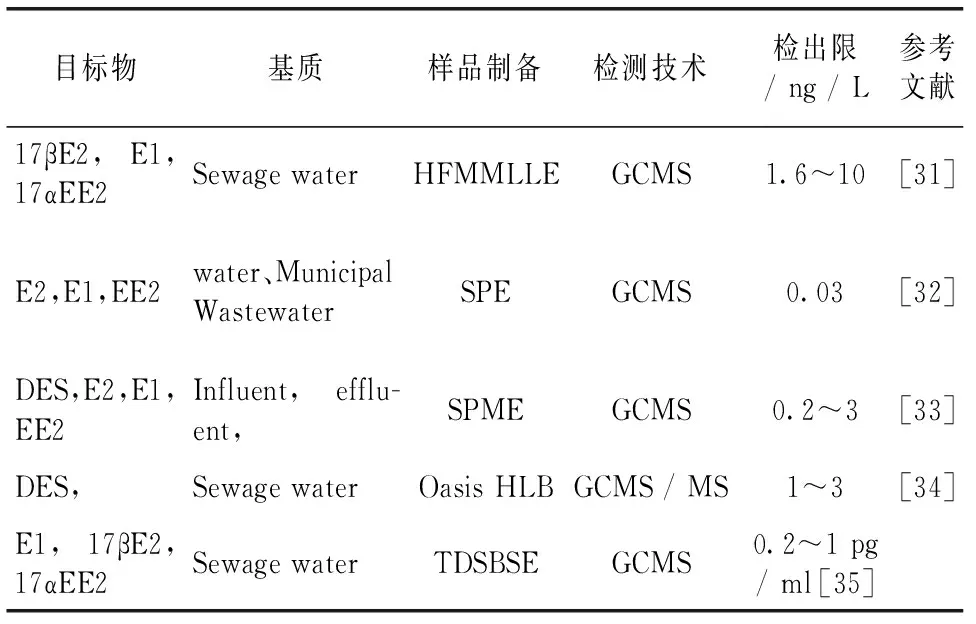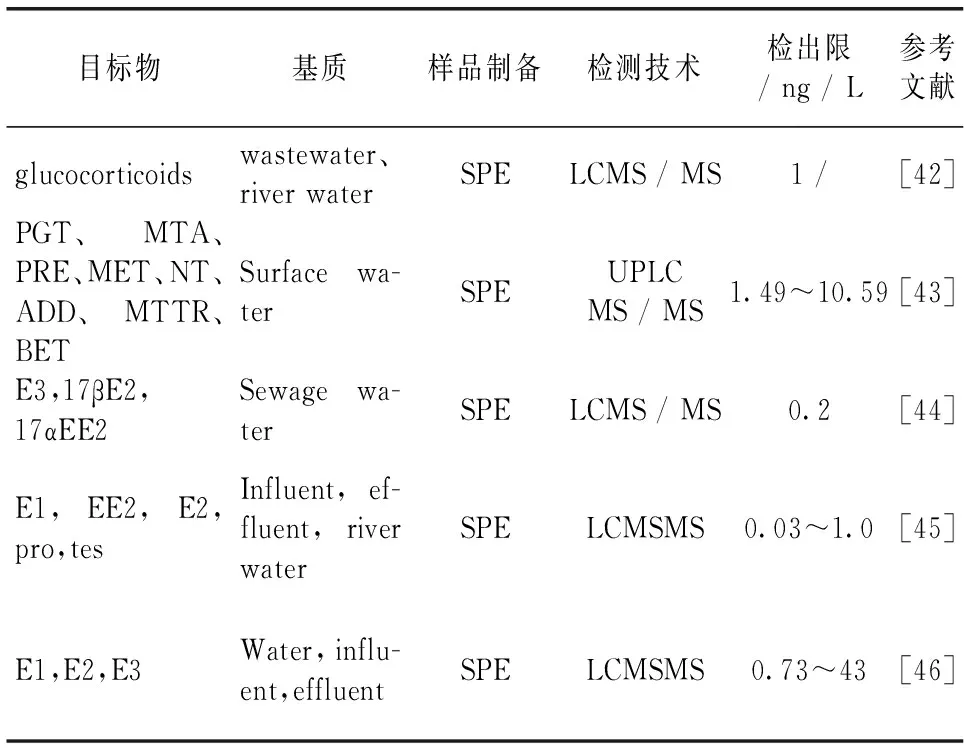环境水体中类固醇激素的分析方法研究进展
李贵洪,谭 红,梁发明,谢 勋
(1贵州大学,贵州 贵阳 550001;2.贵州省分析测试研究院,贵州 贵阳 550001)
环境水体中类固醇激素的分析方法研究进展
李贵洪1,谭红2,梁发明2,谢勋2
(1贵州大学,贵州贵阳550001;2.贵州省分析测试研究院,贵州贵阳550001)
摘要:类固醇激素是一类新型有机污染物,可通过食物链放大作用在生物和人体内富集,从而干扰生物和人体正常的内分泌机能,因此类固醇激素的研究已逐渐成为国际上环境和健康领域的研究热点。对废水中类固醇激素的前处理方法和仪器分析方法进行了综述,主要包括样品萃取、生物技术、气相色谱—质谱联用技术和液相色谱—质谱联用技术。
关键词:废水;类固醇激素;分析方法;研究进展
类固醇激素(steroid hormone)是一类典型的内分泌干扰物,因其在环境中普遍存在和较强的内分泌干扰效应,已是继臭氧层破坏和全球气候变暖之后的第三大环境问题。类固醇激素在极低的剂量即可引起极强的内分泌干扰效应[1],它作为环境激素的重要成员一直以来都是学术界研究的热点。它产生于20世纪30年代,人们采用人工合成的方法生产DES(乙烯雌酚)用作药品以及纺织工业的洗涤和印染用剂,这种合成激素在诞生的同时就被指出有导致恶性肿瘤的危险。有研究结果表明类固醇雌激素在 ng / L 水平可诱导卵黄蛋白原生成、引起雄鱼雌性化和哺乳动物生殖障碍以及免疫力低下等问题[2,3]。环境中危害较大、较为典型的类固醇类内分泌干扰物有:雌酮(Estrone,E1)、雌二醇(Estradiol,E2)、雌三醇(Estriol,E3)、乙炔雌二醇(Ethynylestradiol,EE2)、孕酮(Progesterone,P)、睾酮(Testosterone,T)、甲睾酮(Methyltestosterone,MeT)、雄烯二酮(Androstenedione,ADD)、甲基炔诺酮(Norgestrel,Ng)等。这类物质一旦进入环境,就会对生物体以及人类产生极大的危害。目前,国内外研究了这类物质在污水处理厂、地下水、河流、湖泊中的存在状况[4-7]。但是由于环境水体中类固醇激素的浓度通常为ng / L或pg / L且基质复杂,因此需要灵敏度高的分析方法和能达到富集、消除干扰基体的前处理技术。
1样品萃取技术
样品前处理有提取、净化、浓缩等步骤,可以起到富集目标组分、消除或降低基体干扰、提高灵敏度的作用。样品前处理操作过程是一个十分容易引入误差且耗时的步骤,处理的好坏直接影响分析的最终结果,且样品前处理这一步骤对环境造成的污染最大,因此改善和优化样品制备技术是一个关键问题。目前已有固相萃取、固相微萃取、液液微萃取等方法。
1.1固相萃取
固相萃取(Solid Phase Extraction,SPE)是一种当下流行的用固态吸附剂净化液体样品的前处理方法。通常固相萃取小柱是用在样品前处理过程中,以达到纯化、富集和分离目标物的目的。常用的固体吸附剂有键和硅胶类(如十八烷基硅烷C18)、键和氧化物硅胶(氧化铝修饰的硅胶)、有机聚合物系列(Oasis HLB、聚苯乙烯共聚物)等。目前广泛使用的是Oasis HLB固相萃取柱,该柱子即使活化和上样时抽干了,也能对目标物有保留,其对类固醇类激素的吸附容量很大,一般是硅胶柱的3倍,可用于非极性和极性组分的萃取,回收率可达67 %~109 %[8,9]。固相萃取使两相分离更简单、操作简便、有机溶剂使用量少、样品量不受限制、能够自动化、回收率高、重现性好、净化效果好且价格低廉等优点,在环境水体中类固醇激素的分析过程得到了广泛的运用。目前有离线固相萃取和在线固相萃取这两种方式。离线SPE操作繁琐,在预处理、上样、洗脱、氮吹这些步骤会耗费大量时间且容易造成目标物的损失。在线SPE克服了离线SPE的缺点,但是该方式仪器要求高、建立方法耗时长。
1.2固相微萃
固相微萃取(Solid Phase Micro—Extraction,SPME)是加拿大Pawliszyn教授的研究小组于1989年为解决气相色谱快速进样问题而首次进行开发研究的一项样品前处理技术[10]。该技术是在固相萃取的基础上发展起来的,保留了固相萃取的全部优点,掘弃了需要柱填充物和使用有机溶剂进行解析的缺点[11]。这种无溶剂技术允许集采样、萃取、浓缩、进样于一体,且操作简单、快速、灵敏,适用于不挥发、半挥发和挥发性的化合物,因此这种方法被运用于富集环境水体中的类固醇激素,该方法的回收率在71 %~121 %之间[12,13]。但是SPME存在一些弊端:如使用时间有限,涂层纤维价格昂贵且选择性差。为解决固相微萃的缺点,目前发展起来的有分子印迹涂层固相微萃(Molecularly imprinted polymers coatedSPME)、管内固相微萃(In—tube SPME)、搅拌子吸附萃取(StirBarSorptiveExtraction,SBSE)等技术。但这些技术也存在不足之处:分子印迹涂层固相微萃由于稳健性低每次需要新的MIP且操作难;管内固相微萃由于毛细管容易堵塞,因此需要十分干净的样品;搅拌子的涂层聚二甲基硅氧烷是非极性,因此搅拌子吸附萃取只能运用于非极性和弱极性的化合物。
1.3液相微萃
液相微萃取(Liquid—phase microextraction,LPME)是20世纪90年代由Jeannot和Cantwell等最初报导的一种样品前处理新技术,其基本原理是目标分析物在样品与小体积有机萃取溶剂之间达到分配平衡,从而实现溶质的微萃取[14]。LPME是在液液萃取技术的基础上发展起来的,与液液萃取相比,它克服了操作技术繁琐、污染大、有机溶剂使用量大等弊端,同时该技术集采样、萃取、浓缩于一体,然后直接进样到GC或HPLC进行分离分析。该技术是一项环境友好的样品前处理新技术,特别适用于环境样品中痕量级别污染物的测定。目前运用于类固醇激素的检测有中空纤维液相微萃取(Hollow—fiber liquid—phase microextraction,HF—LPME)、单滴液相微萃取(Solid—drop microextraction,SD—LPME),这些方法的回收率都在80 %~120 %之间[15,16]。HF—LPME技术的主要优点是样品可以搅拌或剧烈振动,提取液也不会有任何损失,但缺点在于膜需要预先处理且当膜重复利用时具有记忆效应。SD—LPME技术操作简便、成本低廉、富集效果好,但主要缺点是提取溶剂的选择有限且需要冷冻提取。
2检测方法
2.1生物技术
目前,测定类固醇激素的生物技术有放射免疫法(RIA)和酶联免疫吸附法(ELISA),虽然这两种灵敏度比较高、速度快、所需样品体积小,但是放射性免疫法容易受与类固醇激素具有类似结构物质的干扰;酶联免疫法样品制备复杂、影响因素多且一次只能分析一种物质。Nelius Swart等[17]用酶联免疫吸附法测定污水中雌酮、雌二醇、雌三醇的含量,样品经C18固相萃取柱净化浓缩,该方法检出限达到了0.2~5.0 ng / L,回收率在84 %~110 %之间,批间和批内的准确率都在10 %内。Shishida等[18]使用酶联免疫的方法检测工业试验规模的污水处理厂出水中的雌二醇,方法的检测限达到了10 ng / L。Tschmelak等[19]用选择性的生物传感器检测雌酮,检测限达到 1.4 ng / L。虽然有以上相关文献报道,但是生物技术检测污水中的类固醇激素还不够完善。表1列出了一部分生物技术在检测环境水体中类固醇激素的应用。

表1 生物技术在类固醇激素检测中的应用
备注:E1:雌酮;E2:雌二醇;E3:雌三醇; EE2:乙炔雌二醇 Pro:孕激素;Tes:睾酮;Influent:污水处理厂进水;effluent:污水处理厂出水;potable water:饮用水;raw water:未处理过的水
2.2气相色谱质谱联用法
气相色谱-串联质谱法(Gas Chromatography—Tandem Mass spectrometry,GC—MS / MS)和气相色谱-质谱联用(Gas Chromatography—Mass spectrometry,GC—MS)已经发展成为一种成熟且涉及领域广泛的分离检测技术,该技术结合了气相色谱分离效率高和质谱定性能力强等优点,因此具有灵敏度高、选择性好、能效高、速度快等特点,已成为检测类固醇激素的主要方法。但是类固醇激素目标物不容易挥发,因此样品需要在气相色谱-质谱法分析前进行衍生化处理,将目标物转化成易于分析检测的化合物。样品衍生化这一步骤使得前处理操作变得复杂,因此可能造成目标物损失且不同目标物的衍生的效率差别很大,这成为气相色谱-质谱测定类固醇类激素的弊端。Lihua Yang等[25]用气相色谱质谱法检测广东三角区河水中雌酮、雌二醇、睾酮的含量,前处理用全自动固相微萃和在纤维上衍生,检测限在0.001~0.124 μg / L之间。Kolodziej等[26]使用气质联用法检测农场附近地表水中的雌二醇、孕酮、雄烯二酮等类固醇激素化合物,检测限在0.1~0.2 ng / L之间。过去的十多年中,应用气相色谱-质谱联用法分离检测类固醇激素的工作已经取得良好的结果[27—30]。表2列出了一部分气相色谱-质谱法在检测环境水体中类固醇激素的应用。

表2 气相色谱质谱联用法在类固醇激素检测中的应用
备注:E1:雌酮;E2:雌二醇; EE2:乙炔雌二醇;DES:乙烯雌酚;Influent:污水处理厂进水;effluent:污水处理厂出水;Sewage water:污水。
2.3液相色谱-质谱联用法
液相色谱-串联质谱法(Liquid Chromatography—Tandem Mass spectrometry,LC—MS / MS)和液相色谱-质谱联用技术(Liquid Chromatography—Mass spectrometry,LC—MS)对于高沸点、难挥发和热不稳定化合物的分离和测定具有极大的优势而成为近年来发展很快的一种新的分析检测技术。目前,随着超高液相色谱技术和三重四级杆质谱技术的发展,大幅度地改善了水体中痕量类固醇激素分析时的分离度、灵敏度和准确性,备受越来越多科研工作者的青睐[36]。Sara等[37]采用SPE—LC—ESI—MS / MS同时检测河水及污水中的雌酮、雌二醇、雌三醇、乙炔雌二醇等物质,该方法前处理时间仅需要1h,检测限在0.02~1.02 ng / L之间,回收率在74 %之上,重现性在1.43 %~3.89 %之间。Qin等[38]通过亲水性色谱与串联质谱联用的方法检测人体尿液中的雌激素,其检出限为2~1 000 pg / L,回收率在92 %~109 %之间。Vulliet E等[39]采用SPE—LC—ESI—MS检测了污水处理厂中类固醇激素的含量,在喷雾器压力60 psi;干燥气体N2温度350 ℃;干燥气体流量13 L / min;毛细管电压5000 V;碰撞电压75 V的条件下,该方法检测雌激素的检出限在0.9—4—3ng / L,雄激素和孕激素的检测限为1ng / L。Will J.Backe[40]用液液萃取加衍生的方式检测河水中5种雌激素,该方法仅仅用了7.5 ml的样品检出限就低至0.13 ng / L。在实际应用中,大部分科研工作者都使用ESI离子源接口,负离子状态检测雌激素,正离子检测孕激素和雄激素。因为这几类化合物的极性弱,比较难电离,灵敏度不是很好,在优化各个条件时发现毛细管电压、离子源温度和去溶剂流速,对灵敏度都会有显著的影响[41]。目前,由于LC—MS与LC—MS / MS价格高昂,其使用的广泛性受到了一定限制。表3列出了一部分液相色谱—质谱法在检测环境水体中类固醇激素的应用。

表3 液相色谱质谱联用法在类固醇激素检测中的应用
备注:E1:雌酮;E2:雌二醇; E3:雌三醇;EE2:乙炔雌二醇;Pro:孕激素;Tes:睾酮;PGT :孕酮;MTA :六甲强龙;PRE :泼尼松;MET:安宫黄体酮;NT:诺龙;ADD:雄烯二酮;MTTR:甲基睾酮BET:倍他米松;glucocorticoids:糖皮质激素;Influent:污水处理厂进水;effluent:污水处理厂出水;Sewage water:污水;Urine:尿液;Surface water:地表水
3结语
随着样品前处理技术、色谱、质谱及色谱-质谱联用技术的迅猛发展,科研工作者对类固醇激素在环境中的污染来源、污染特征、迁移规律、降解机理和在生物体内的生物效应等方面的核心问题有了逐渐的了解。在痕量类固醇激素的检测和分析过程中,样品的前处理发挥着重要的作用。目前很难找到一个完善的方法从高度复杂的样品基质中萃取出类固醇激素目标物,因此样品前处理过程仍然是类固醇激素分析的“瓶颈”步骤。建立高通量的样品预处理技术,将会大大降低检测和分析成本与时间,建立在线同时处理、分离和检测类固醇激素的方法和技术,将是类固醇激素分析方法发展的一个趋势。虽然国内外都对一些水域中的类固醇类激素进行了检测,但调查范围十分有限,大多数集中在污水处理厂及受纳水体和集约化养殖场,特别是我国目前缺少对该类物质在全国水域范围内的全面调查,污染现状及其变化趋势还尚不清楚。
参考文献【REFERENCES】
[1]Hansen P.D,Dizer H.,Hock B.,Marx A,Sherry J,McMaster M,BlaiseC.Vitellogenin — ABiomarker for Endocrine Disruptors[J].Trac—Trend in Anal Chem,1998,17(7):448—451.
[2]Thorpe K.L,CummingsR I,Hutchinson T H,Scholze M,BrightyG,Sumpter J P,TylerC R.Relative potencies and combination effects ofsteroidal estrogens in fish[J].Environ Sci Technol,2003,37(6):1142—1149.
[3]Aerle R V,Pounds N,HutchinsonT H,Maddix S,Tyler C R.Windowof sensitivity for the estrogenic effects of ethinylestra—diol in early life—stages offathead minnowPimephalespromelas[J].Ecotoxicology,2002,11(6):423—434.
[4]Guo F,Liu Q,Qu G B,Song S J,Sun J T,Shi J B;Jiang,GB.Simultaneous determination of five estrogens and four androgens in watersamples by online solid—phase extraction coupled with high—performance liquidchromatography—tandem mass spectrometry[J].Journal of Chromatography A.2013,1281(6):9—18.
[5]Arnon S,Dahan O,Elhanany S,Cohen K,Pankratov I,Gross A,Ronen Z,BaramS,Shore LS.Transport of testosterone and estrogen fromdairy—farm waste lagoons to groundwater[J].Environ Sci Technol,2008,42(15):5521—5526.
[6]DennisD F,Breidenbach G P,Treaver L P,et a1.Quanti—tationof estrogens in ground water and swine lagoon samples using solid— phase extraction,Pentafluorobenzyl / trimethylsilylderivatizations and gas chromatography—negative ion chemical ionization tandem mass spectrometry[J].Journal of Chromatography A,2003,1017(1—2):167—185.
[7]He X W,Ying Z ,Qing W J.Simultaneous screening of estrogens,progestogens,and phenols and their metabolites in potable water and river water by ultra—performance liquid chromatography coupled with quadrupole time—of—flight mass spectrometry[J].Microchemical Journal,2012,100(1):83—94.
[8]ádám T lgyesi,Zita Verebey,Virender K.Sharma.Simultaneous determination of corticosteroids,androgens,and progesterone in river water by liquid chromatography—tandem mass spectrometry[J].Chemosphere,2010,78(8):972—979.
[9]葛峰,谭丽超,单正军,王懿.污水中18 种类固醇激素化合物的痕量分析[J].分析测试学报,2011,30(11):1295—1300.
GE F,TAN L C,SHAN Z J,WANG Y.Analysis the trace of 18 kinds of steroid hormone compounds in wastewater[J].Journal of Instrumental Analysis,2011,30(11):1295—1300.
[10]傅若农.固相微萃取(SPME)近几年的发展[J].分析试验室,2015,34(5):602— 620.
FU R N.The development of solid phase microextractionin recent years[J].Chinese Journal Analysis Laboratory,2015,34(5):602— 620.
[11]魏黎明,李菊白,等.固相微萃取法在环境监测中的应用[J].分析化学,2004,32(12):1667—1672.
WEI L M,LI J B,et al.The application of solid phase microextraction in environmental monitoring[J].Chinese Journal of Analytical Chemistry,2004,32(12):1667—1672.
[12]ZHANG Z M,DUAN H B,ZHANG L,et al.Direct determination of anabolic steroids in pig urine by a new SPME—GC—MS method[J].Talanta,2009,78(3):1083—1089.
[13]YANG L H,LUAN T G.Solid—phase microextraction with on—fiber silylation for simultaneous determinations of endocrine disrupting chemicals and steroid hormones by gas chromat—ography—mass spectrometry[J].Journal of Chromatography A,2006,1104(1—2):23—32.
[14]Jeanno M A,Cantwell F F.Mass transfer characteristics of solvent extraction into a single drop at the tip of a syringe needle[J].Anal.Chem,1997,69(2):235—239.
[15]Zorita S,Mathiasson L,Hallgren P.Steroid hormone determination in water using an environmentally friendly membrane based extraction technique[J].Journal of Chromatogr.A,2008,1192(1):1—8.
[16]Chang C C,Huang S D.Determination of the steroid hormone levels in water samples by dispersive liquid—liquid microextraction with solidification of a floating organic drop followed by high—performance liquid chromatography[J].Anal.Chim.Ac—ta,2010,662(1)39—43.
[17]Swart N,Pool E.Rapid detection of selected steroid hormones from sewage effluents using an ELISA in the Kuils River water catchment area[J].Immunoassay Immunochem,2007,28(4):395—408.
[18]Shishida K,EehigoS,Kosaka K,TabasakiM.Evaluation of advanced sewage treatment processes for reuse of wastew—ater reusing bioassays[J].Environmental Technology,2000,21(5):553—560.
[19]TsehmelakJ,ProllG,GauglitzG.Optical biosensor for pharm—aceuticals,antibiotics,hormones,endocrine disrupting chemicals and pesticides in water:Assay optimization process for estrone as example[J].Talanta,2005,65(2):313—323.
[20]Chang H—S,Choo K—H,Lee B,Choi S—J.The methods of identification,analysis,and removal of endocrine disrupting com—pounds(EDCs)in water[J].Journal of Hazardous Materials,2009,172(1):1—12.
[21]ManickumT,John W.Occurrence fate and environmental risk assessment of endocrine disruptor compounds at the waste—water treatment works in Pietermaritzburg South Africa[J].Sci Total Environ,2013,468—469(1):584—597.
[22]Garcia SN,Clubbs RL,Stanley JK,Scheffe B.Compara—tive analysis of effluent water quality from a municipal treatment plant and tow on—site wastewater treatment systems[J].Chemosphere,2013,92(1):38—44.
[23]Aherne GW,Briggs R.The relevance of the presence of certain synthetic steroids in the aquatic environment[J].Pharm—acy & Pharmacol,1989,41(10):735—736.
[24]Shore LS,Gurevitz M,Shemesh M.Estrogen as an environmental pollutant[J].Bulletin of Environmental Contamination and Toxicology,1993,51(3):361—366.
[25]LiH Y,ChongY L,Liu HT,Dong J.Tian G L.Full automation of solid—phase microextraction / on—fiber derivatization for simultaneous determination of endocrine—disrupting chemicals and steroid hormones by gas chromatography—mass spectrometry[J].Anal Bioanal Chem,2006,386(2):391—397.
[26]Kolodziej E.P,Sedlak D.L.Rangeland grazing as a source of steroid hormones to surface waters[J].Environ Sci Technol,2007,41(10):3514—3520.
[27]Zhang K, Zuo YG.Pitfalls and solution for simultaneous determination of estrone and 17a—ethinylestradiol by gas ehromatography—mass Spectrometry after derivation with N,O—bis—(trimethylsilyl)trifluoroaeetamide[J].Anal.Chim.Aeta,2005,554(1—2):190—196.
[28]Shareef A,Angove M J,Wells J D.Optimization of silylation using N—methyl—N—(trimethylsilyl)—trifluoroacetamide,N,O—bis·(trimethylsilyl)—trifluoroacetamide and N—(tert—butyldimethylsilyl)—N—methyltrifluoro—acetamide for the determination of the estrogens estrone and 17 alpha—ethinylestradiol by gas chromatography— mass spectrometry[J].Journal of Chromatogr A,2006,1108(1):121—128.
[29]Peng X Z,Wang Z D,Yang C,Chen F R.Simultaneous determination of endocrine—disrupting phenols and steroid estrogens in sediment by gas chromatography—mass spectrometry[J].Journal of Chromatogr A.2006,1116(1—2):51—56.[30]Trang T,Harden NB,Coleman HM,et al.Simultaneous determination of estrogenic and androgenic hormones in water by isotope dilution gas chromatography—tandem mass spectrometry[J].Journal of Chromatography A,2011,1218(12):1668—1676.
[31]Jagerdeo E,Abdel—RehimM.Screening of cocaine and its metabolites in human urine samples by direct analysis in real—time source coupled to time—of—flight mass spectrometry after online preconcentration utilizing microextraction bypacked sorbent[J].the American Society for Mass Spect,2009,20(5):891—899.
[32]Suri R P S,Singh T S,ChimchirianRF.Effect of process conditions on the analysis of free and conjugated estrogen hormones by solid—phase extraction—gas chromatography/mass spectrometry(SPE—GC/MS)[J].Environ Monit Assess,2012,184(3):1657—1669.
[33]Carpinteiro J,Quintana J B,et a1.Applicability of solid—phase microextractiom followed by on—fiber silylation for the determination of estrogens in water samples by gas chromatography—tandem mass spectrometry[J].Journal of Chromatogr A,2004,1056(1—2):179—185.
[34]Quintana J B,CarpinteiroJ,et a1.Determination of natural and synthetic estrogens in water by gas chromatography with mass pectrometricdiction[J].Journal of Chromatogr A,2004,1024(1—2):177—185.
[35]Sanja R,Niri V.H,Dajana D,Pawliszyn J.Recent developments in solid—phase microextraction[J].Anal.Bioanal.Chem,2009,393(3):781—795.
[36]Gabet V,CoqueryM,et a1.Analysis of estrogens inenvironmental matrices[J].Trends in Analytical Chemistry,2007,26(11):1113—1131.
[37]Sara R M,Barceló D et al.Picogram Per liter level determination of estrogens in natural waters and waterworks by a fully automated on—line solid phase extraction.liquid chromatography—electrospray tandem mass Spectrometry method[J].Anal Chem,2004,76(23):6998—7006.
[38]Qin F,Zhao Y Y,Sawyer M B,etal.Hydrophilic interaction liquid chromatography tandem mass spectrometry determination of estrogen conjugates in human urine[J].Anal Chem,2008,80(9):3404—3411.
[39]Vullet E,Baugros J B,Flament Walton M M,Grenier—Loustalot M F.Analytical methods for the determination of selected steroid sex hormones and corticosteriods in wastewater[J].Anal Bioanal Chem,2007,387(6):2143—2151.
[40]Will J.Backe.An Ultrasensitive(Parts—Per—Quadrillion)and SPE—Free method forthe quantitative analysis of estrogens in surface water[J].Environ.Sci.Technol.2015,49(24),14311—14318.
[41]Guo T D,Taylor R L,Singh R J,et al.Simultaneous determination of 12 steroids by isotope dilution liquid chromatography—photospray ionization tandem mass spectrometry[J].Clinica Chimica Acta,2006,372(1—2):76—82.
[42]Adrian A A,Petra M,Ksenia J G.LC—MS / MS determination of potential endocrine disruptors of corticosignalling in rivers and wastewaters[J].Anal Bioanal Chem,2014,406(29):7653—7665.
[43]谭丽超,葛峰,孔德洋,周军英,单正军.南京市地表水中18种类固醇激素的检测分析[J].环境化学,2014,33(2):298—305.
TAN L C,GE F,KONG D Y,ZHOU Z Y,SHAN Z J.Detection 18 kinds of steroid hormone insurface water of Nanjing[J].Environmental Chemistry,2014,33(2):298—305.
[44]Koh Y.K.K,Boobis A,Chiu T Y,et al.Determination of steroid estrogens in wastewater by high performance liquid chromatography—tandem mass spectrometry[J].Chromatography A,2007,1173(1—2):81—87.
[45]Chang H,Wan Y,Wu S,Fan Z,Hu J.Occurrence of androgensandprogestogens in wastewater treatment plants and receiving riverwaters:comparison to estrogens[J].Water Res,2011,45(2):732—740.
[46]Li,Zheng W,Kelly WR.Occurrence and removal of pharmaceutical and hormone contaminants in rural wastewater treatment lagoons[J].Science of the Total Environment,2013(445—446)22—28.
投稿日期:2015-12-29;修回日期:2016-01-20
Progress of analysis method on steroid hormones in wastewater
LI Guihong1,TAN Hong2,LIANG Faming2,XIE Xun2
(1GuizhouUniversity,Guiyang550001,China;2GuizhouAcademyofanalysistest,Guiyang550001,China)
Abstract:Steroid hormone is a new type of organic pollutant,which can be enriched in biological and human body through the food chain,so as to interfere with the normal endocrine function of organism and human body.Therefore,the study on Steroid hormone has become an international research focus.The pretreatment method and instrumental analysis method on steroid hormone in wastewater were summarized,including sample extraction,biological technology,gas chromatography—mass spectrometry technology and liquid chromatography—mass spectrometry technology.
Keywords:wastewater;steroid hormone;analysis method;research progress
中图分类号:X 830
文献标识码:A
文章编号:1003—6563(2016)02—0064—06
作者简介:李贵洪(1993-),女,四川南充人,硕士。研究方向:环境分析。

